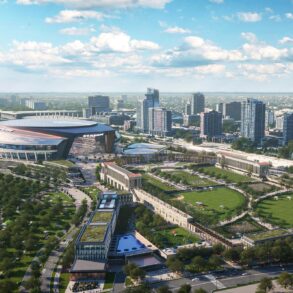
Jean-Michel Gathy is at the origin of the most beautiful hotels in the world. The award-winning Belgian architect and interior designer with over four decades of experience at the avant-garde of the hospitality industry, who describes himself as “the spoiled child of the hotel industry”, founded his firm Denniston in 1983. He debuted his career thanks to Adrian Zecha, president of Aman, who offered him the opportunity to design the Amanwana in Indonesia in 1989. Since then, he has masterminded more than a dozen Amans, effectively defining the brand’s DNA, and collaborated with the most prestigious hotel groups across the globe such as Cheval Blanc, Mandarin Oriental, Four Seasons and One&Only. Behind the Marina Bay Sands infinity pool in Singapore, the Aman New York and the Jumeirah Bali, a tropical modernist sanctuary perched atop the cliffs of Uluwatu, his projects in 2024 include the launch of One&Only One Za’abeel Dubai, Cheval Blanc Seychelles and Aman Nai Lert Bangkok. Now he has been named by Aman as the first designer to lead its brand-new sister brand, Janu, which recently opened the Janu Tokyo in the Japanese capital’s vibrant new beating heart, Azabudai Hills, boasting views of the iconic Tokyo Tower.
Why have you made hotel design your signature?
I would say it’s a succession of opportunities. Hans Jenni and Adrian Zecha gave me the opportunity to design luxurious boutique hotels, and I liked it, so I stuck in that world. I’ve been designing for 40 years, I’ve made a lot of mistakes, but I’ve also learned a lot. I think that after 25 years, if you have spent your time operating on clients for the heart, you have become a good cardiologist. Well, we have become good cardiologists. We have done luxurious hotels and we have made fewer and fewer mistakes every time. Now we are known as the go-to architects for this because we have done so many and all the famous ones always choose us. In Miami, we have The Setai, the best hotel in America, then we did Amanyara, the best hotel in the Caribbean, then we did One&Only, the best hotel in the Indian Ocean, then we did The Chedi Andermatt and the Aman Venice, the best hotels in Europe. It just goes on and on. So progressively, we get not only knowledgeable about it, but we get a kick out of it. And the more we live within that context, the more we appreciate the lifestyle, the more we understand it, the more we like it.
The Skyline Loft at the One&Only One Za’abeel Dubai
Photo courtesy of Denniston
Tell me about the influence of Adrian Zecha, an Indonesian hotelier and founder of several international hotel companies including Regent Hotels, GHM Hotels, Aman Resorts and Azerai Resorts.
Adrian Zecha opened the door for me and I just stayed in it. I believe I have made not too many mistakes and therefore people know this now. So whenever they do a first-class hotel, they call us automatically. We get basically two or three offers a day. Every day, I could bid for two hotels. We don’t automatically get it, but we get invited every day. Of course, we can’t take them all. We did the Rosewood Hoi An. I’ve never designed a Rosewood before, but they invited us and I’m excited because Rosewood has successfully refocused their standards and they’re becoming a very good company, so I said yes.
Why do you pay particular attention to water features?
It’s simple. There are two types of hotels: urban hotels and resort hotels. In urban hotels, of course I use much less water first because there is no space. Very often, it’s a vertical tower because the land cost in the middle of town is always so high that you have no choice than to go vertical, maximize density. Therefore, there is little water, but in a resort hotel, when you are in the mountains or when you are at the sea or when you are in the countryside, all this is beautiful around you during the day because you can see. But look out your window when you are in Port Dickson or in Singapore, when you look towards the sea after 7 o’clock, it’s pitch dark, so you see nothing. So your whole experience of the day is gone. At night, the first thing you do is you close your curtains, you live in your room, so what do you need to do, what scenery can I give you? The best way to create scenery is water. Firstly, it’s cheap. Secondly, it has two or three functions. One is reflective surfaces, which means it increases space and creates drama. Reflecting trees in a pond is very dramatic and increases space by double, of course, because it plays the role of a mirror. Then you can use it for noise. When you are on a terrace with other people dining next to you, all you need is some fountain or water noise, and it just cuts the conversation so you have privacy. So it creates privacy, it creates drama, it creates décor, it reflects and creates a larger space. So water at night is paramount in a resort because you have lost the effect of the day: the view.
The Aman Nai Lert Bangkok is slated to open in the third quarter of 2024
Photo courtesy of Denniston
What about your inclusion of swimming pools?
I have designed many big swimming pools. Why? Because every hotel, like a village or a city, needs a center. Look at Singapore. Everybody goes on the weekend to Orchard Road. Why? Because people want to see people, they want to see life, they like to have activities, they like to feel that they belong to a community. They don’t like places which are boring. Therefore, the center of the village in a hotel, 90 % of the time, is the swimming pool. So you don’t want a swimming pool that’s too small because then people step on each other, and obviously it becomes unpleasant. You have to create a large swimming pool, large waterways or large things so people can be together with others yet have some space and privacy. Besides that, it also serves very well the hotel industry because they use that for marketing purposes. You never see the marketing of a hotel without showing you a gorgeous swimming pool because in the minds of people, a swimming pool, beach, sea or palm tree means holiday, relaxation and I’m going to have a good time.
Describe to me your iconic mountain resorts: The Viceroy Snowmass, The Chedi Andermatt and The St. Regis Lhasa.
This is different. It’s not the pool that counts. It becomes an internal pool for obvious reasons, but the interest of the winter or the mountain resort is of course the word “coziness”. People go to a resort like Andermatt because it’s cozy, they want to feel cuddled. Dogs like a kennel because they feel in a cocoon, man likes a cozy hotel. They like to feel that they are protected from the elements. They warm themselves around the fireplace as opposed to being outside in the snow, the wind or the rain, so the ultimate target for a resort in the mountains is coziness, comfort. I always say that if I have to qualify a good hotel, I would only use one word: comfort. If it’s not comfortable, for me, it’s not a good hotel. It can be gorgeous, but if it’s not comfortable, it’s not well-designed. That’s my opinion. Comfort is the quality of the hotel. Privacy is good, but comfort, when I am in my bed, I want to sleep properly. When I’m in my shower, I want proper pressure. When I want a view, I want a proper view. If I have a swimming pool, I don’t want it to be four meters deep, I want to be able to stroll in it, I want to be able to lounge in the pool. I want to have a terrace. I want a fireplace if it’s cold. So comfort is the ultimate word for me for a luxurious hotel. Whether I’m in the mountains, at the beach or in the middle of New York, I like to stay in hotels where I feel good: I have room for my luggage, I can hang my shirt, the telephone must work, I need to be able to call for room service, I want a spa, I want comfort.







